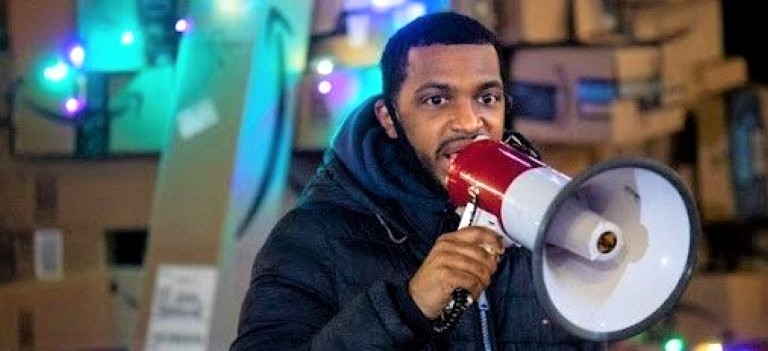Last Wednesday, Derrick Palmer clocked in for his 7:15am shift at Amazon’s giant warehouse on Staten Island and spent the day packing boxes with board games, iPhones and mini vacuum cleaners.
The following morning, he boarded a train to Washington, D.C., where more experienced labor leaders hailed him and his best friend, Christian Smalls, for doing what had once seemed impossible: unionizing an Amazon facility.
In the past week, their David-versus-Goliath victory has become a symbol of growing worker power. On a recent episode of “The Daily,” the two men relayed the twists and turns of their story, from a fateful misdirected email that rebounded in their favor, to the D.I.Y. tactics they used, like free marijuana and bonfires, to forge a bond with co-workers.
But whether their victory will last is far from assured. In the coming weeks, the fight between the new union and Amazon is likely to become even more heated. Amazon is marshaling its legal might to try to overturn the election.
The new union will attempt to win another, more difficult vote at a second Staten Island location. And everyone will be watching to see if similar efforts emerge at other Amazon facilities — and whether the company will be able to extinguish them.
As this unfolds, here are three questions to watch for:
-
What does this union want?
Smalls and the other Amazon Labor Union leaders won in large part because the Staten Island workers have a long, varied list of frustrations.
This week, he said that the A.L.U. was prepared to demand broad changes in Amazon’s working conditions and on safety, pay and benefits. But the campaign lacks the kind of single, galvanizing goal, like a $15-an-hour minimum wage, that has given other labor organizing efforts a focal point.
Amazon, partly responding to the political pressures of the national minimum wage campaign, raised wages to $15 in 2018 and now pays an average starting pay of more than $18 an hour.
-
How will Amazon respond?
To overturn the election, Amazon would have to meet a high bar, proving not only that misconduct occurred but that the problems were so widespread that they tainted the entire vote, Wilma Liebman, a former head of the National Labor Relations Board, explained.
But no matter the outcome, or whether the new group succeeds in negotiating a contract, the company has a larger question to answer: How will it respond to the underlying concerns that allowed the union drive to get this far?
Amazon, in a sense, faces the same conceptual challenge that the new union does: The list of workers’ grievances with the company is just so long.
A New York Times investigation last year revealed how strained Amazon’s labor model had become, with a sky-high 150 percent annual turnover rate and a low-trust, management-by-machine approach. In contrast to its precise handling of packages, its human resources systems were so overtaxed that we found a pattern in which the company inadvertently fired its own employees. Injury rates continue to be a serious concern. And there’s more.
On Thursday, in his first letter to shareholders since taking over as chief executive, Andy Jassy acknowledged the breadth of problems.
“We’ve researched and created a list of what we believe are the top 100 employee experience pain points and are systematically solving them,” he wrote.
But Amazon, known for its ambition, shows no sign of making fundamental changes. In yesterday’s letter, Jassy said he would continue to take an “iterative” approach — making repeated tweaks — to the company’s year-old goal of becoming “Earth’s Best Employer.”
-
Will other warehouses follow?
Smalls has said that workers at more than a hundred other Amazon facilities have contacted the union, interested in organizing at their locations.
In an interview this week, he said that the A.L.U. now plans to go national. If the Staten Island efforts prove contagious, Amazon would start looking more like Starbucks, where more locations are voting to unionize every week.
But it’s too early to tell if anything like that will happen. “Let’s not make a single event a movement,” Andrew Stern, the former president of the Service Employees International Union, said in an interview this week. “We don’t know whether this is an extraordinary occurrence or a reproducible event.”
Last month, in another contested election, workers at an Amazon warehouse in Alabama appear to have narrowly rejected unionizing, though the margin is close enough that the results will not be known until hundreds of contested ballots are litigated.
The key difference between Amazon and Starbucks is the sheer size of each site, which must individually unionize. For Starbucks, the union needs about 20 votes to prevail in a single cafe; at Amazon, with its enormous warehouses, the union needs more than a thousand, making each election a far harder task.
The stakes of this fight could not be higher for Amazon, whose entire retail model rests on a coast-to-coast chain of manual labor, or for unions themselves. Despite the rapid organizing at Starbucks — and the frequent arrival of high-profile examples of other new organizing efforts — union membership has been on a downhill slope for decades.
If workers at Amazon — the nation’s second-largest employer, and perhaps the most influential one of our time — decide they don’t want or need unions, or cannot overcome Amazon’s resources, it will be an ominous sign for the relevance of organized labor. So expect nothing less than a bitter, messy, drawn-out battle that could help determine the future of American work.
Jodi Kantor and Karen Weise are reporters with the New York Times. Copyright, The New Y ork Times.

